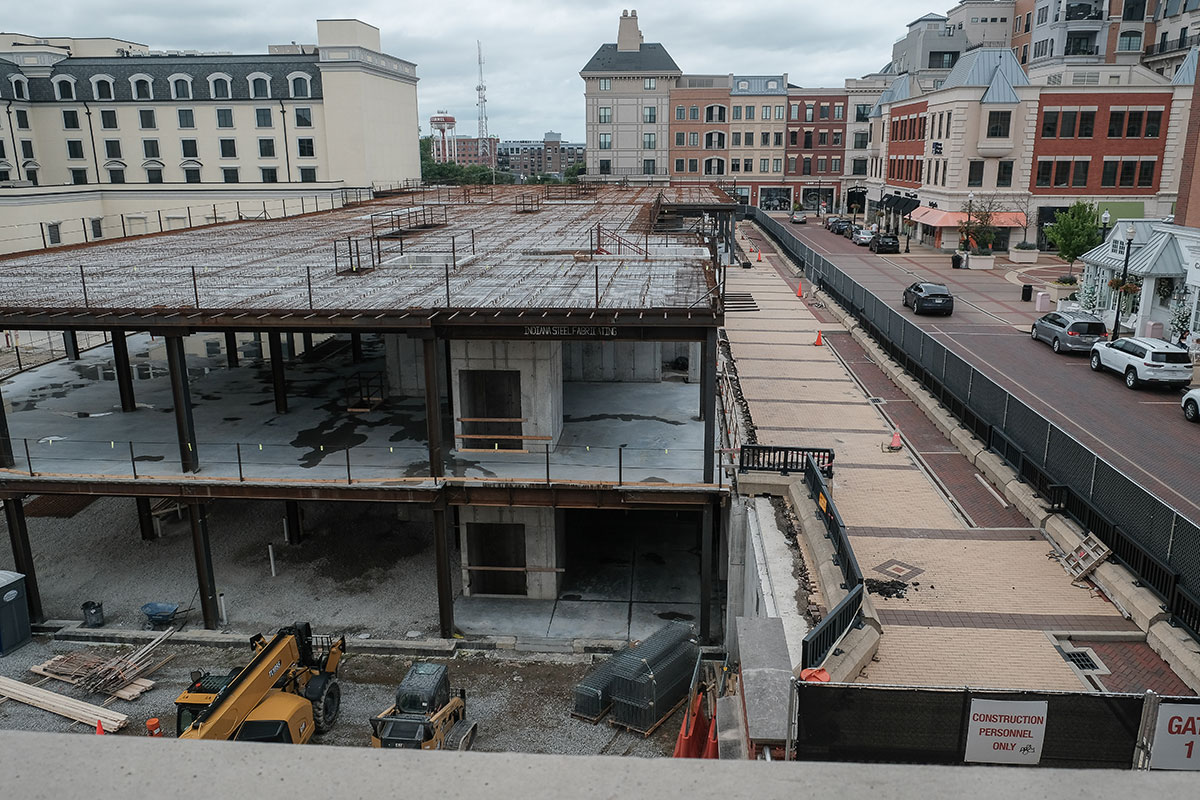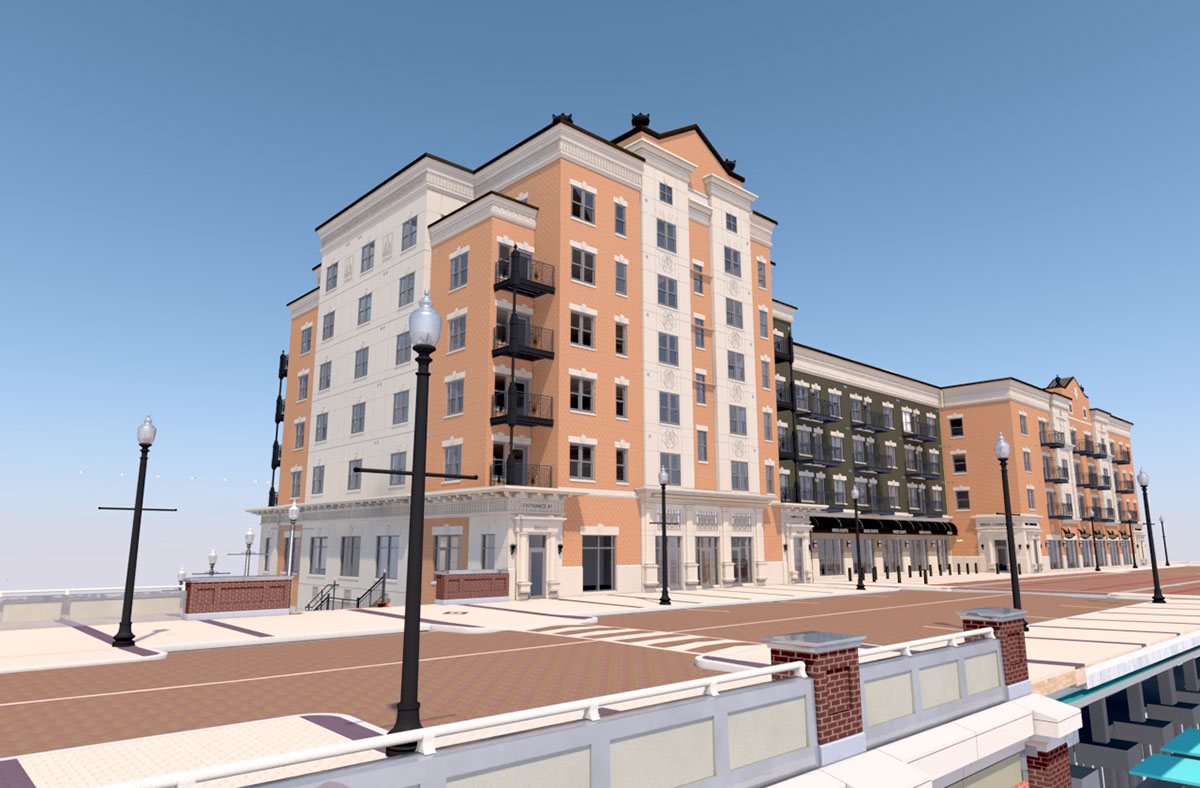Subscriber Benefit
As a subscriber you can listen to articles at work, in the car, or while you work out. Subscribe NowAfter more than two decades of planning, construction and delays, the finish line is finally within sight for Carmel’s City Center.
Two mixed-use buildings—the Wren and Windsor—under construction this summer are the final pieces of the $300 million development that created a new core for Carmel and became home to some of the city’s most recognizable landmarks.
Carmel-based developer Pedcor Management Corp. expects the six-story, 157,000-square-foot Wren just east of Hotel Carmichael to be complete late next year or early in 2024. Site work has begun south of the hotel on the four-story, 64,000-square-foot Windsor. It is expected to open in 18 to 24 months.
“The Wren—you can see the steel is up already and they’ll start working on the upper floors here soon,” Carmel Redevelopment Commission Executive Director Henry Mestetsky said. “And the Windsor, they’re just digging out. They’re putting in foundations.”
Both buildings will include a mix of residential and commercial space that officials and developers say will complement City Center’s existing hotel, apartments, shops and restaurants.
Pedcor Senior Vice President Melissa Averitt said commercial space in the Windsor will likely include offices or service businesses. The Wren, which will have more than 50,000 square feet of commercial space, is expected to offer office space on the street level and restaurants or retail on the lower, plaza level.
The construction of Wren and Windsor follows the recent completion of two other City Center buildings: Hamilton West, which has about 14,000 square feet of business and retail space, and Playfair and Holland, which are two connected, five-story buildings with a combined 178,000 square feet of space, including 112 luxury apartments and 63,000 square feet of commercial space.
Hamilton West is attached to the west side of the Veterans Way Garage, next to the Playfair and Holland.

Brainard’s baby
City Center began as a $77 million idea more than two decades ago from Mayor Jim Brainard.
“When I first ran for mayor [in 1995], I knocked on thousands of doors and asked people what their hopes and dreams and aspirations were for the city. I heard a lot of things, but one thing I heard was, we didn’t have a downtown,” Brainard told IBJ in May. “Carmel at the end of World War II, I think, was still under a thousand people, so the little two-block downtown that we had [in the 1990s] wasn’t big enough.”
A comprehensive plan completed in 1997 by the Carmel Plan Commission estimated that by 2020 all land in Carmel would be developed and the city’s population would grow from about 60,000 residents to 85,000, according to a report by the Indiana University Public Policy Institute.
Discussion began that year about ideas for the City Center Redevelopment Area Plan, which the Carmel Redevelopment Commission approved in January 1998. The first construction work on City Center began July 9, 1998, at a groundbreaking ceremony for the intersection of East 126th Street and City Center Drive.
Construction in the following years included work on the Carmel Bike Shop and the now-Carmel City Center Apartments (2000), Rotary Plaza (2001), and the Ryland Townhomes and Shapiro’s Deli complex (2002).
The city in 2003 announced plans for the Carmel Arts & Design District, and the next year awarded Pedcor with the bid for the development company’s signature project.
The first phase of Pedcor’s work on City Center, a half mile south of Carmel’s original, two-block downtown (now the heart of the Arts & Design District), began with groundbreaking in March 2006. It included the theater venues, 106 apartment units, 62,000 square feet of retail and commercial space, and 46,500 square feet of office space in two buildings. The palatial 1,600-seat Palladium concert hall opened in 2011.
Pedcor then proposed its $100 million second phase in late 2013, beginning with The Nash, a three-story building along Rangeline Road with 10,000 square feet of retail space and 30 apartments.
The second phase added 10 buildings and 575,000 square feet to City Center.
The developer and city expected to finish City Center in 2019 but encountered multiple delays—including problems during the pandemic that affected materials and costs.
Construction on the Wren, for example, originally was slated to begin in fall 2016, but was bumped back several times.
The mixed-use project is now home to the Palladium, Booth Tarkington Civic Theatre, Hotel Carmichael, downtown living options, restaurants and shops. During the holiday season, the open space—called Carter Green—just south of the Palladium hosts Christkindlmarkt.
“The impressive design and architecture of this area, coupled with the increased density, was planned to create a more attractive visibility to the businesses that locate here,” Averitt said. “We wanted to create a project that had the appeal of a neighborhood, while offering the vibrancy of a downtown.”
Cost questions
But the total price tag for City Center, which eventually ballooned to $300 million, has led to some criticism and skepticism over the years.
“The real confusion is in trying to track the financing, and I’m not sure that a team of PhD’s could do it,” said Mike Shaver, president of Carmel-based Wabash Scientific Inc.
Pedcor agreed to provide an array of financial guarantees in case of delays, including a payment-in-addition-to-taxes agreement—known as a PIATT.
The developer also secured a $4 million letter of credit from a federally regulated bank that is renewable each year the tax increment financing bond the city issued in 2005 to cover payments for the Veterans Way Garage is outstanding.
The funds, which have not been needed, were meant to be used in case the development of specific buildings stalled or assessments fell short of expectations.
A final layer of protection, also not needed, was a special benefits tax that could be levied on all property owners if TIF revenue fell short any time during the life of a $20 million bond issued in December 2014 to fund infrastructure work and the parking garage.
Mestetsky, the city’s chief planner, said he appreciates that Pedcor “always said, ‘We would rather build it right than build it faster,’ and every building they put up is unique.”
“They delivered on what they said they were going to do,” he said. “They built a totally architecturally unique-in-the-world product.”
He compared the look of City Center to European cities, rather than typical American suburbs with strip malls.
“I’ve said that, if there were three or four other Pedcors in this city, central Carmel would look like Charleston [South Carolina],” Mestetsky said. “They care about architecture and urban design as much as city planners do, and that’s not normal.”

Around Carmel
And Carmel’s core is widening beyond City Center and its adjacent developments just north—Midtown and the Arts & Design District.
About a dozen other buildings within a couple of miles are in varying stages of construction this summer. Mestetsky told the Carmel City Council last month that he doesn’t think the city has ever had so many cranes up at one time.
“Summer is construction season, and it just happened to be that so many of these things that we were working on for so long are all happening at the same time,” he told IBJ, adding that the city is no longer building out its “skeletal system.”
“Right now, we’re filling in the different parts, so we can have projects going on Main and Old Meridian at the same time it’s happening on 116th and Rangeline at the same time it’s happening right in the middle of Main Street at the same time it’s happening in Midtown and City Center,” Mestetsky said. “We’re at this place where it’s happening everywhere.”
Three major projects underway include:
◗ 1st on Main: The $47 million, 73,000-square-foot, four-story building developed by Carmel-based Lauth Property Group Inc. will include first-floor restaurant space, eight condominiums, 35 apartments and a 310-space public parking garage. The project at the northeast corner of West Main Street and South Rangeline Road is expected to be finished next summer.
◗ The Signature: The $78 million building at West Main and Old Meridian streets is to feature 295 luxury apartments, eight condominiums and 16,100 square feet of retail. The development also includes a 374-space parking garage and over 20,000 square feet dedicated to resident amenities. Indianapolis-based Tegethoff Development is making its Carmel debut with the project.
◗ The Corner: Indianapolis-based Kite Realty Group began construction late last year at the northwest corner of East 116th Street and South Rangeline Road on the $69 million project that will include 278 apartments, 25,000 square feet of office and retail space, and a 364-space public parking garage.
“After Midtown is when it’s fair to say we hit this critical mass or this momentum of [being able to see] the vision of what our central core could be,” Mestetsky said. “And since then, we’ve just been fortunate to continue doing these projects.”•
Correction: An updated and expanded timeline of work on Carmel’s City Center has been added to this story.
Please enable JavaScript to view this content.





Pedcor originally guaranteed to the Carmel City Council that the 10 City Center buildings would be completed by 2019.
Two of those buildings were to have been hotels built at Pedcor’s cost.
This episode puts the old shameful “day late and a dollar short” to shame.
Some liken the design of Carmel’s City Center to Charleston, SC. A trained eye would be reminded of Disneyland.